Categories(658 Blogs)
Select Category
Watch Right Now
Teacher App - Class
Schedule & Attendance Management App
Parent App from Edsys

Best School Bus Tracking System

Cashless School - For Smart Schools of Tomorrow


States and Capitals of India 2023: 28 States and 8 UTs in India
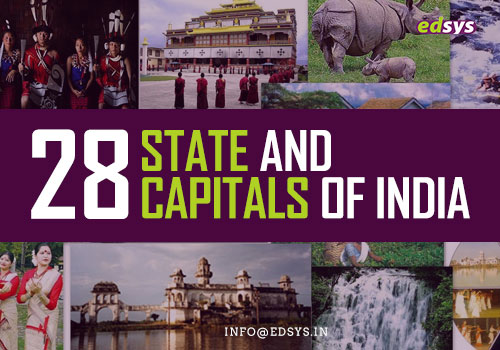
India, one of the most diverse nations in the world, is divided into 28 states and 8 union territories for administrative purposes.
The tradition, culture, art, language, and food vary from state to state and are unique to each region.
Access Here More Than 1000+ FREE Educational Apps
Table of Content
How Many States in India?
States and Capitals of India 2023
List of States and Capitals of India
States and Capitals of India Map
States and Union Territories: What You Should Know?
States and Capitals of India: UT Updates and Specialities
Interesting Facts about States and Capitals of India
States and Capitals of India
India, located in South Asia is the second-most populous country in the world with over 135 crores of people. It is one of the largely diverse countries across the globe that is divided into different states and union territories for governmental purposes.
A parliamentary form of government governs the country and is formally recognized as the Republic of India. The tradition, culture, art, language, and food vary from state to state and are unique to each region. Let us have a glimpse into some of the key details regarding the states and capitals of India.
How Many States are there in India?
As of July 2020, there are 28 states and 8 union territories in India.
The first formed Indian states were Bihar and Odisha (previously Orissa) on April 1, 1936. Since then, the central government went on adding many new states and Union Territories and sometimes merge them based on specific requirements.
India is the seventh-largest country across the globe and managing everything from a single place is not feasible. So the Indian Constitution gives the power to the central government to form different states and union territories in the country.
States and Capitals of India 2023
All states and union territories have a legislative, administrative, and judicial capital. However, some states cover all functions under a single capital.
All the functions of the states are governed by an elected chief minister for a period of 5 years each. Ever since the first state was formed early in 1936, several changes have been made in terms of division of states and capitals and the formation of union territories.
Here let us have a look into the latest updates regarding the list of 28 states, union territories, and their capitals along with a lot of other new changes and interesting facts.
List of States and Capitals of India
Following the independence of India in 1947, states were divided into four lists like parts A, B, C, and D. The States Reorganisation Act, 1956 reorganized the states based on linguistic lines resulting in the creation of the new states.
According to 2020, here are the details of the 28 Indian States and their capitals along with the year in which they were founded and the official language.
| SL no | State | Capital | Founded on | Official Language |
| 1 | Andhra Pradesh | Hyderabad | 1 Nov. 1956 | Telugu |
| 2 | Arunachal Pradesh | Itanagar | 20 Feb. 1987 | English |
| 3 | Assam | Dispur | 26 Jan. 1950 | Assamese |
| 4 | Bihar | Patna | 26 Jan. 1950 | Hindi |
| 5 | Chhattisgarh | Raipur | 1 Nov. 2000 | Hindi |
| 6 | Goa | Panaji | 30 May. 1987 | Konkani |
| 7 | Gujarat | Gandhinagar | 1 May. 1960 | Gujarati |
| 8 | Haryana | Chandigarh | 1 Nov. 1966 | Hindi |
| 9 | Himachal Pradesh | Shimla | 25 Jan. 1971 | Hindi |
| 10 | Jharkhand | Ranchi | 15 Nov. 2000 | Hindi |
| 11 | Karnataka | Bengaluru |
1 Nov. 1956 | Kannada |
| 12 | Kerala | Thiruvananthapuram | 1 Nov. 1956 | Malayalam |
| 13 | Madhya Pradesh | Bhopal | 1 Nov. 1956 | Hindi |
| 14 | Maharashtra | Mumbai | 1 May. 1960 | Marathi |
| 15 | Manipur | Imphal | 21 Jan. 1972 | Meitei |
| 16 | Meghalaya | Shillong | 21 Jan. 1972 | English |
| 17 | Mizoram | Aizawl | 20 Feb. 1987 | Mizo, English & Hindi |
| 18 | Nagaland | Kohima | 1 Dec. 1963 | English |
| 19 | Odisha | Bhubaneswar | 26 Jan. 1950 | Odia |
| 20 | Punjab | Chandigarh | 1 Nov. 1956 | Punjabi |
| 21 | Rajasthan | Jaipur | 1 Nov. 1956 | Hindi |
| 22 | Sikkim | Gangtok | 16 May. 1975 | English |
| 23 | Tamil Nadu | Chennai | 26 Jan. 1950 | Tamil |
| 24 | Telangana | Hyderabad | 2 Jun. 2014 | Telugu |
| 25 | Tripura | Agartala | 21 Jan. 1972 | Bengali, English and Kokborok |
| 26 | Uttar Pradesh | Lucknow | 26 Jan. 1950 | Hindi |
| 27 | Uttarakhand | Dehradun | 9 Nov. 2000 | Hindi |
| 28 | West Bengal | Kolkata | 1 Nov. 1956 | Bengali |
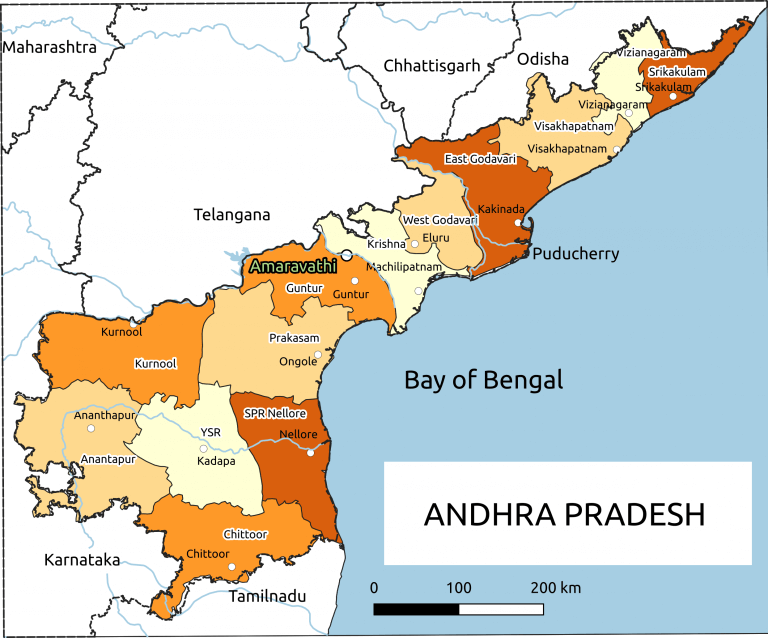
- Capital – Hyderabad
- Language – Telegu
- Area – 160,205 km2
- Dance – Kuchipudi
- Mammal – Blackbuck
- Tree – Neem
- Flower – Jasmine
Andhra Pradesh is located on the southeastern coast of India. The state is into mining activities and industry in addition to agriculture.
Visakhapatnam, a major port, is situated on the coast lining the Bay of Bengal. It is well known for the revered temple Tirupathi, beautiful handloom weaves and the dance Kuchipudi.
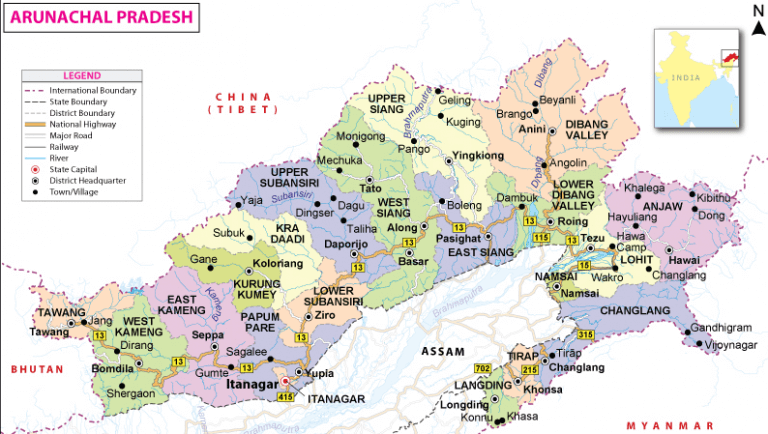
- Capital – Itanagar
- Language – English
- Area – 83,743 km2
- Dance – Aji Lamu, Chalo, Hiirii Khaniing, Popir, Ponung, Pasi Kongki, Rekham Pada, Roppi, Lion and Peacock dance
- Population – 1,382,611
- Mammal – Bos Frontalis
- Tree – Hollong
- Flower – Foxtail Orchid
Arunachal Pradesh is the northeastern state of the country having borders with Bhutan in the west and Myanmar in the east. The McMahon line in the north separates the state from China.
The state is habited by tribes and ethnic groups who speak about 50 languages and dialects. The mountains, lakes, passes, meadows and forests make the state a beautiful one.
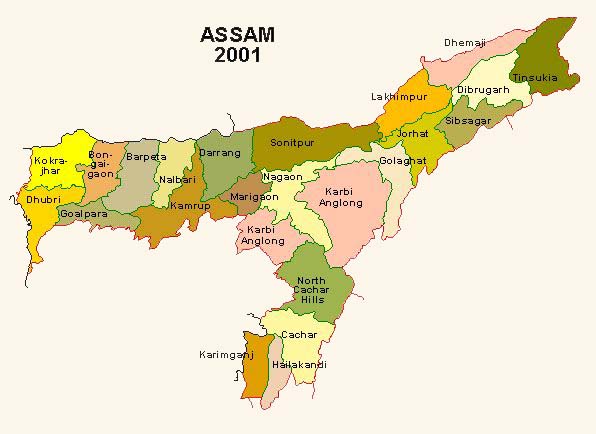
- Capital –Dispur
- Language – Assamese
- Area – 78,438 km2
- Population – 31,169,272
- Dance – Bihu dance
- Mammal – One horned rhinoceros
- Tree – Dipterocarpus, macrocarpus
- Flower -Rhynchostylis retusa
Assam is located in the northeast of India sharing international borders with Bhutan and Bangladesh. Woodlands and grasslands cover the land area. Rice is a major crop for the agriculture-based economy. Assam is the highest producer of tea in the country.
Kaziranga National Park and the Manas wildlife sanctuary is the abode to rhinoceroses, tigers and leopards.
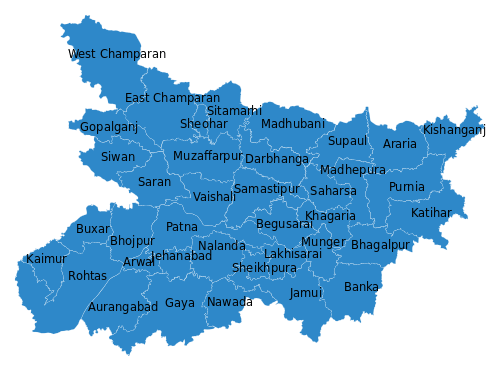
- Capital – Patna
- Language – Hindi
- Population – 103,804,637
- Area – 94,163 km2
- Dance – Jat-Jatin
- Mammal – Gaur
- Tree – Sacred fig
- Flower -Bauhinia variegata
Bihar is a state in East India bordered by Nepal in the north. It was the center of civilization and culture for centuries. Bihar is considered to be a land where Buddha lived and is associated with Buddhism and Jainism.
With agriculture being the basis, rice is the predominant crop. Wheat, barley, pulses, jute, sugarcane and vegetables and fruits are grown extensively.
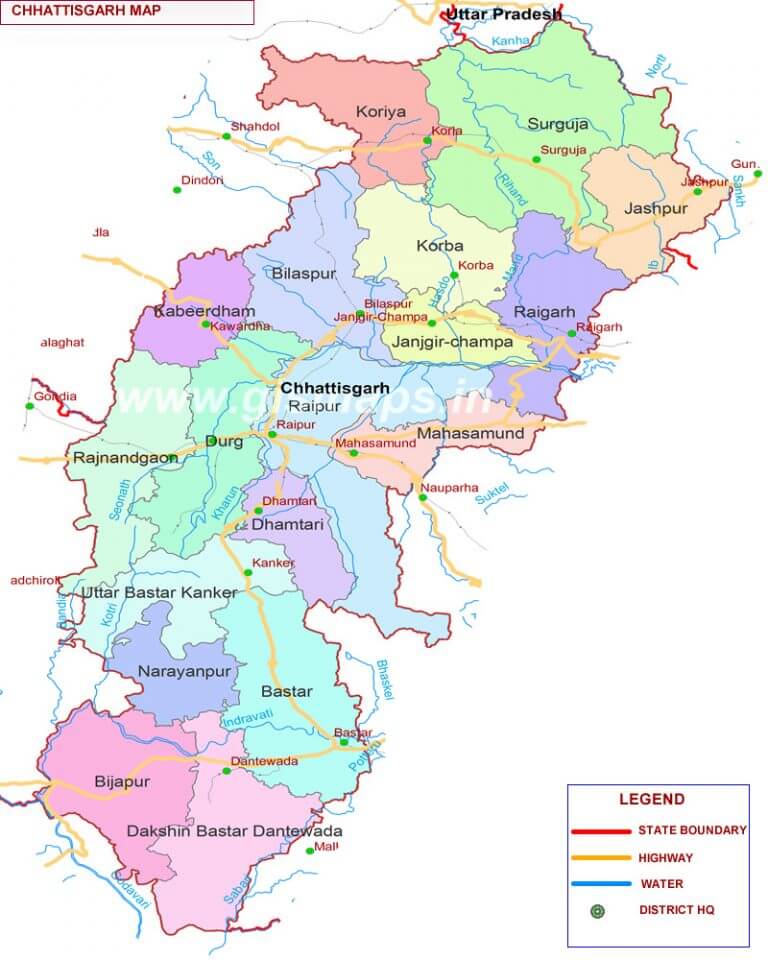
- Capital – Raipur
- Language – Chhattisgarhi
- Population –2.55 crores
- Area -135,191 km2
- Dance – Panthi
- Mammal – Wild Asian Buffalo
- Tree – Sal
- Flower – Lady’s Slipper
Chattisgarh, situated in Central India, has a rich cultural heritage. The state has monuments, carved temples, rock paintings, Buddhist temples, tiger reserves and wildlife sanctuaries.
Agriculture, mining and energy production is the basis of the economy. The state produces the bulk of tendu leaves for making bidis.
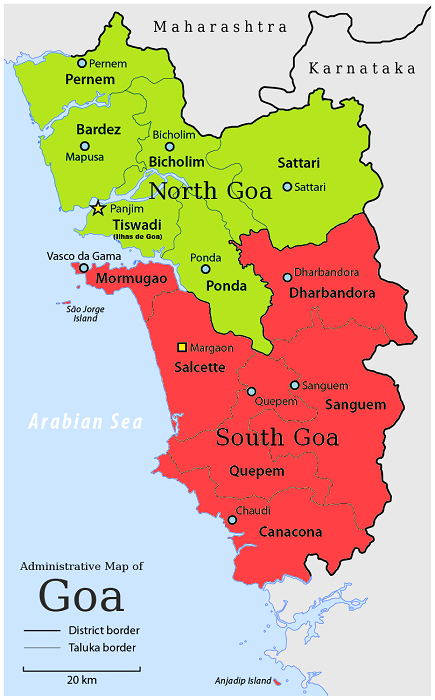
- Capital – Panaji
- Language – Konkani
- Population – 1,458,545
- Area – 3,702 km2
- Dance – Fugdi
- Mammal – Gaur
- Tree – Terminalia elliptica
- Flower – Jasmine
Goa is one of the smallest states in India on the west coast of India. Goa is famous for the Portuguese heritage, its beaches and the sumptuous Goan food.
Rice and coconut are the staple produce. Mining of iron ore, bauxite and manganese have been in prevalence.
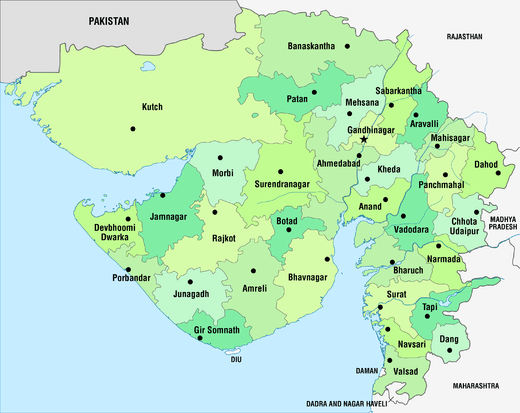
- Capital – Gandhinagar
- Language – Gujarati language
- Population – 6.27 crores
- Area – 196,024 km²
- Dance – Garba
- Mammal – Asiatic Lion
- Tree – Banyan
- Flower – Marigold
Gujarat is on India’s western coast bounded by Pakistan in the north-west. The salt deserts of Kucch, semi arid scrublands of Kathiawar, hills of Girnar form a varied landscape.
Mahatma Gandhi built his Sabarmati Ashram here. The state houses architectural marvels and rich culture and heritage.
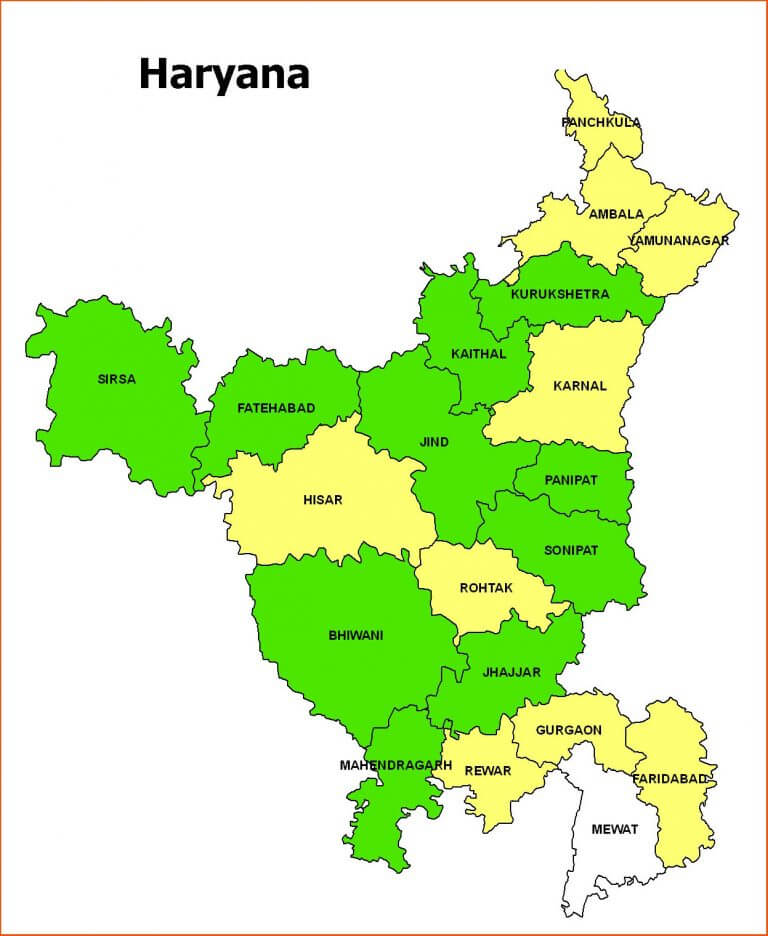
- Capital – Chandigarh
- Language – Hindi
- Population – 2.54 Crores
- Area – 44,212 km²
- Dance – Ghoomar
- Mammal – Blackbuck
- Tree – Sacred Fig
- Flower – Nelumbo Nucifera
Haryana lies in the north of India. The economy of the state centers on agriculture producing large quantities of rice and wheat. Cotton, potatoes and lentils are also grown. The population holds vibrant and colorful celebrations of festivals and arts.
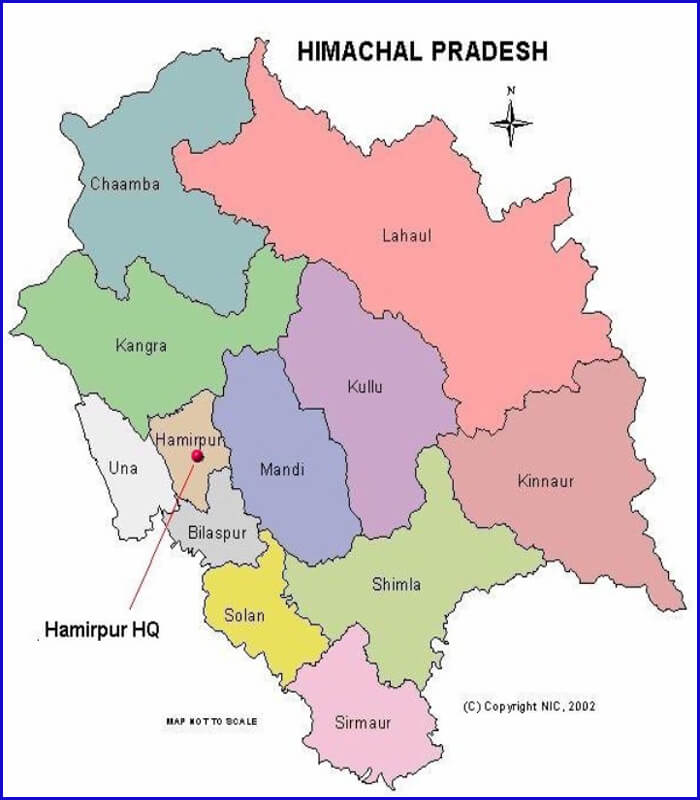
-
- Capital – Shimla
- Language – Hindi
- Population – 68.6 lakhs
- Area – 55,673 km²
- Dance – Nati
- Mammal – Snow leopard
- Tree – Deodar cedar
- Flower -Rhododendron campanulatum
Himachal Pradesh lies in north India, on the foothills of the Himalayas. Livelihood depends on agriculture, horticulture and seasonal herding.
Also Read: Top 12 Longest and Major Rivers of India
The state is abundant with the natural beauty of snow-clad mountains, valleys and streams. The beautiful hill stations of Kulu, Manali, Chamba, Dalhousie, Dharamshala attract tourists.
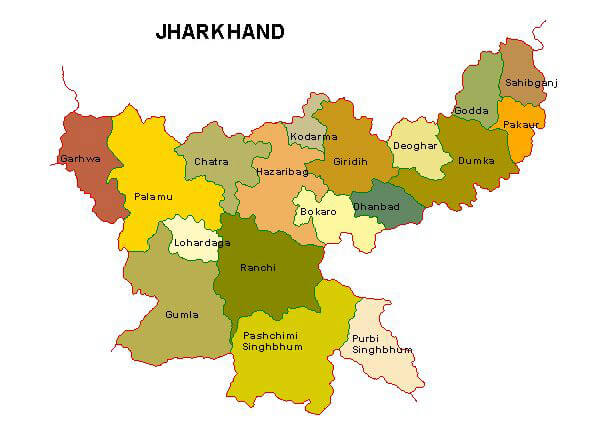
- Capital – Ranchi
- Language – Bengali
- Population – 3.19 crores
- Area – 79,714 km²
- Dance – Paika
- Mammal – Elephant
- Tree – Sal Tree
- Flower – Sacred Tree
Jharkhand in eastern India was formerly a part of Bihar. The state has a diverse culture and tribal presence. The mineral-rich state has a concentration of heavy industries in Jamshedpur, Dhanbad, Bokaro and Ranchi. Agriculture is a mainstay of the state.
The state has dense forests, hills, holy places, waterfalls and wildlife parks which are tourist attractions.
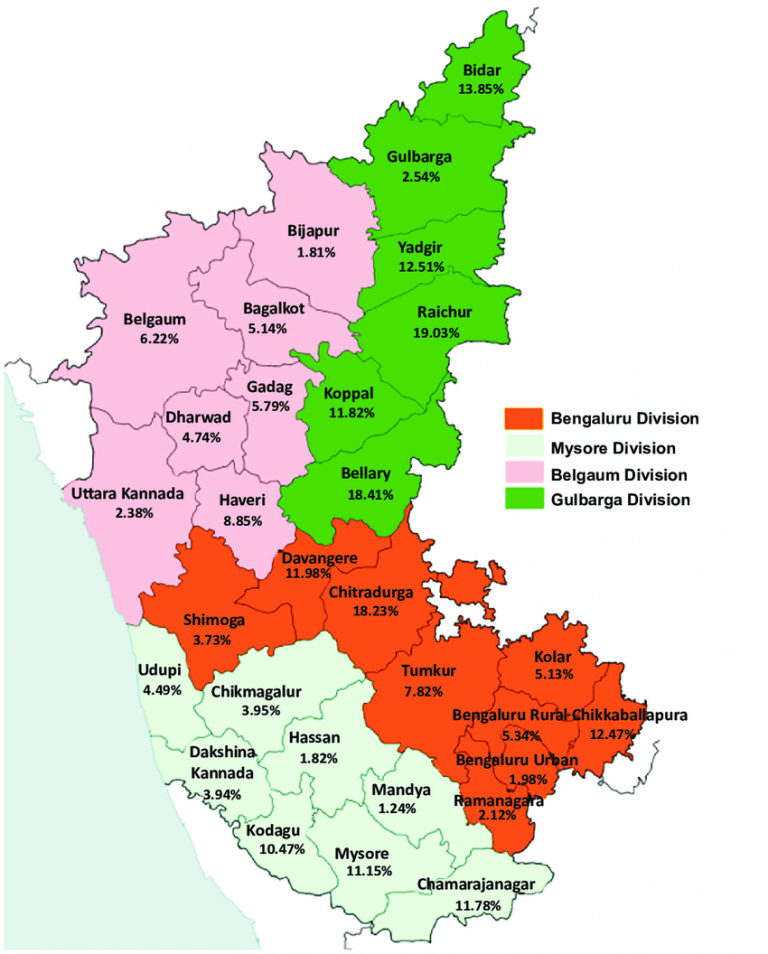
- Capital – Bengaluru
- Language – Kannada
- Population – 6.41 crores
- Area – 191,791 km²
- Dance – Dollu Kunitha
- Mammal – Elephant
- Tree – Indian sandalwood
- Flower – Nymphaea nelumbo
Karnataka is in southwest India lying along the Arabian Sea coastline. The palaces of Mysore and the medieval architecture of Hampi, the capital of Vijayanagar Empire makes the state historically rich.
The mountains, farmlands and the long coastline with beautiful beaches outline Karnataka’s varied landscape. Agriculture, dairy and horticulture earn the major revenue for the state.
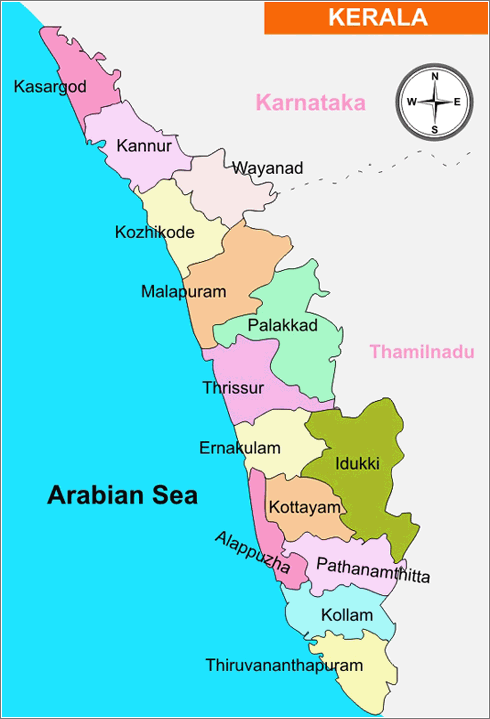
- Capital – Thiruvananthapuram
- Language – Malayalam
- Population – 3.48 crores
- Area – 38,863 km²
- Dance – Kathakali
- Mammal – Asian Elephant
- Tree – cocunut
- Flower -Golden Shower Tree
Kerala is a state on the southern-most tip of India abundant in scenic beauty.
The Arabian Sea shoreline offers beaches and backwaters. The mountains of the Western Ghats houses national wildlife parks and hill stations.
Also Read: 24 Most Popular National Festivals of India
In an agriculture-based economy the cash crops are rubber, coffee and tea. Cardamom, cashew, coconut and pepper fetch high revenues.
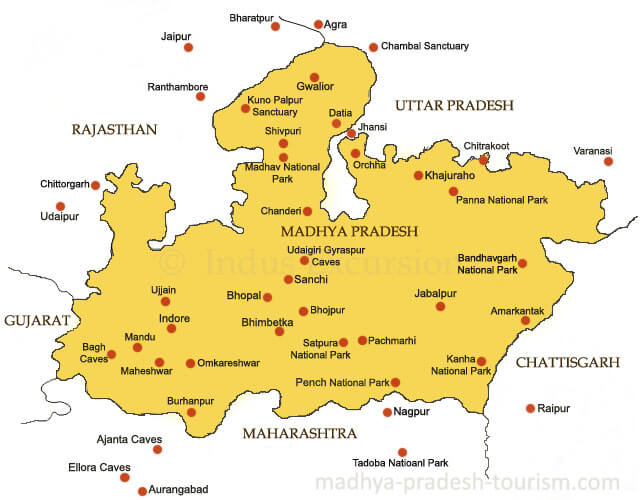
- Capital – Bhopal
- Language – Hindi
- Population – 7.33 crores
- Area – 308,252 km²
- Dance – Maanch dance
- Mammal – barasingha
- Tree – Banyan
- Flower – Sacred Tree
Located in the center of India, Madhya Pradesh is the largest state in India with no coastline or international borders. The topography consists of low hills, plateaus and river valleys. Agriculture is the basis of the economy. Fertile valleys rich in alluvium are cultivated here.
Hindu and Jain temples of Khajuraho, national parks and Bengal tiger sanctuaries are the main tourist attractions in the state.
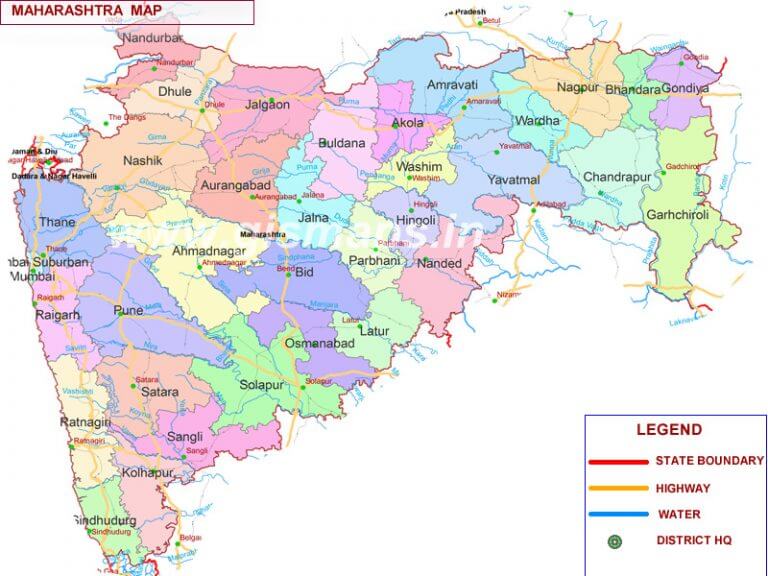
- Capital – Mumbai
- Language – Marathi
- Population – 112,372,972
- Area – 307,713 km2
- Dance – Marathi
- Mammal – Indian giant squirrel
- Tree – Mango Tree
- Flower – Jarul
Maharashtra is on the west coast of India and occupies a substantial portion of the Deccan Plateau.
This state is India’s biggest industrial and commercial, manufacturing, finance and administration hub. Mumbai is the most important port in handling foreign trade.
Mumbai is a very vibrant city with a multi-cultural population of diverse religions.
Gateway of India and the elephant caves of the British raj era are now tourist destinations.
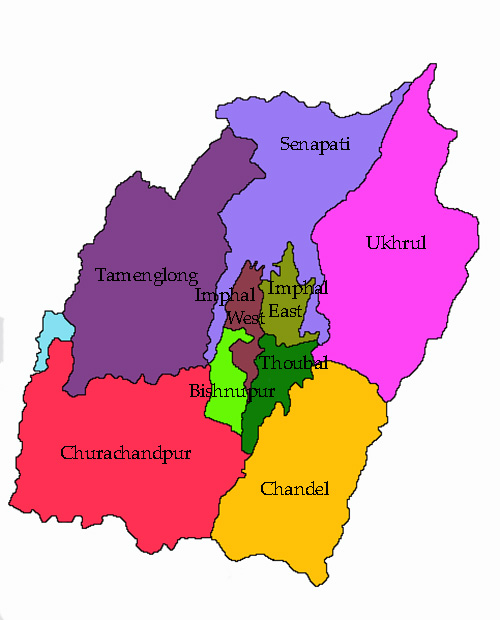
- Capital – Imphal
- Language – Meitei
- Population – 2,855,794
- Area – 22,327 km2
- Dance – Marathi
- Mammal – Sangai
- Tree – Shirui lily
- Flower – Uningthou
Manipur is in north-eastern India. Agriculture and forestry form the basic income source. There are cottage industries in silk production and bamboo crafts.
The exotic landscapes, green valleys, hills, lakes and forests are attractions to tourists. The only floating park in the world, the Kelbul Lamjao National Park is in Manipur.
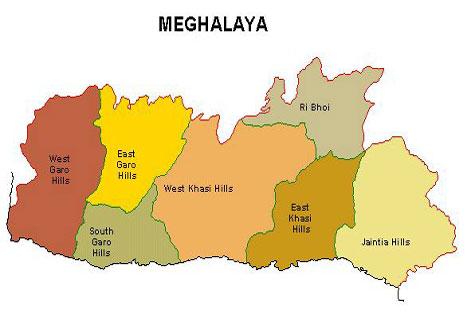
- Capital – Shillong
- Language – Khasi, Pnar and Garo with English
- Population- 26.5 lakh
- Area – 22,720 km²
- Dance- shad nongkrem
- Mammal – elephants, bear, red pandas
- Tree – Dieng-lophiang (Khasi).
- Flower – Paphiopedilum insigne
Meghalaya in the north-east of India is a hilly state with high rainfall, subtropical forests and biodiversity.
Chirapunji which receives the maximum rainfall in the world is in Meghalaya.
Meghalaya is dependent on agriculture and forestry. Rice, maize, potatoes, pineapple, papaya and bananas are the main constituents of agricultural produce.
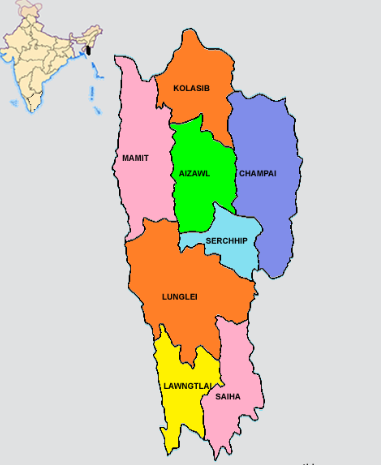
- Capital – Aizawl
- Language – Mizo ṭawng
- Population-11.2 lakhs
- Area – 21,081 km²
- Dance – Sarlamkai
- Mammal – red serow
- Tree – Mesua ferrea
- Flower – Renanthera imschootiana
Mizoram is situated in north-west India having international borders with Burma and Bangladesh.
More than three-fourths of the land area is covered with forests that provide habitats for animal life. Agriculture is the mainstay of the state.
The moderate climate, even in summer, makes the high hills and peaceful surroundings excellent tourist destinations.
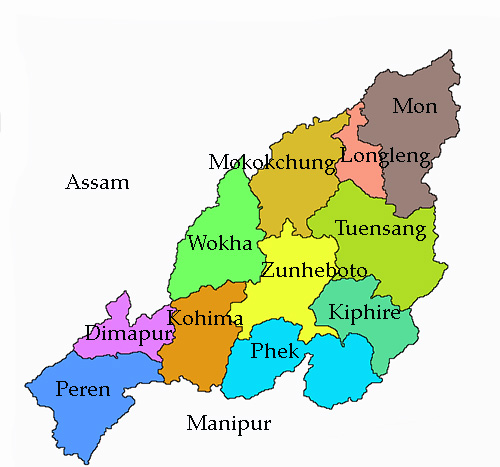
- Capital – Kohima
- Language – English
- Population-22.8 lakhs
- Area – 16,579 km²
- Dance – War Danceand Zeliang Dance.
- Mammal – Himalayan striped squirrel (Tamiops mcclellandii)
- Tree – Alnus nepalensis
- Flower – Rhododendron arboreum
Nagaland in the northwest of India is mountainous and shares an international border with Myanmar.
The capital city hosts museums and ancient weaponry as memorials to their trials in the Second World War. The main occupation of the populace is agriculture.
Nagaland is mainly inhabited by tribes who speak about 60 dialects. Their colorful costumes, spicy food, beautiful dances and festivals attract very many tourists all year round.
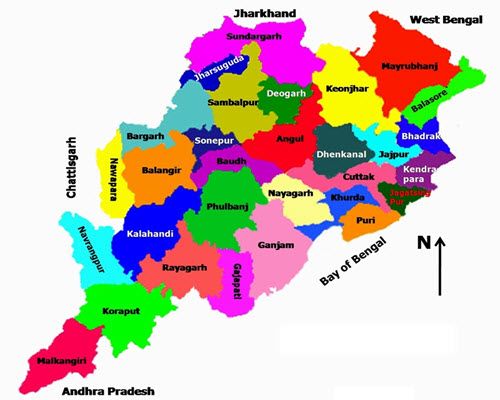
- Capital – Bhubaneswar
- Language – Odia
- Population- 4.6 crores
- Area – 155,707 km²
- Dance – Odissi
- Mammal – Sambar
- Tree – Banyan Tree
- Flower – Ashoka tree
Odisha is on the eastern side of India on the Bay of Bengal. Forests cover one-third of the land area.
Though most of the land is not suitable for cultivation, the predominant occupation is agriculture.
The temples of Bhubaneswar and Puri, the temple of Konark and long stretches of beaches are the major tourist attractions.
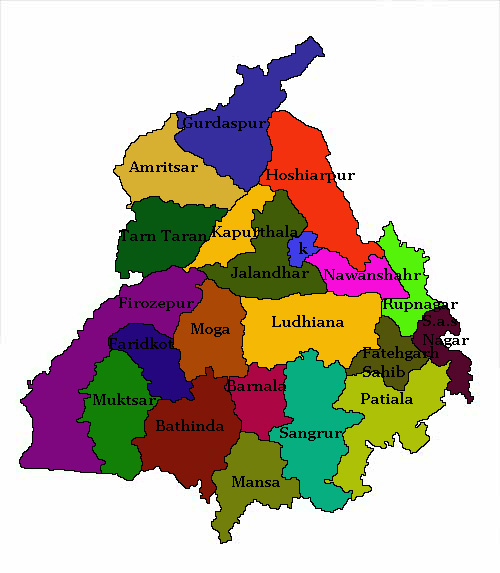
- Capital – Chandigarh
- Language – Punjabi
- Population-2.8 crores
- Area – 50,362 km2
- Dance – bhangra
- Mammal – Blackbuck
- Tree – Indian rosewood
- Flower -Lilium Candidum
Punjab, in the west of India, is the heart of the Sikh community. Punjab is known as the land of five rivers, Ravi, Beas, Chenab, Sutlej, Jhelum, and this network of rivers irrigate the land.
Agriculture is the basis of the economy. Rice and wheat form the major share of the crop. Legumes and pulses, fruits, oilseeds, cotton and vegetables are also grown.
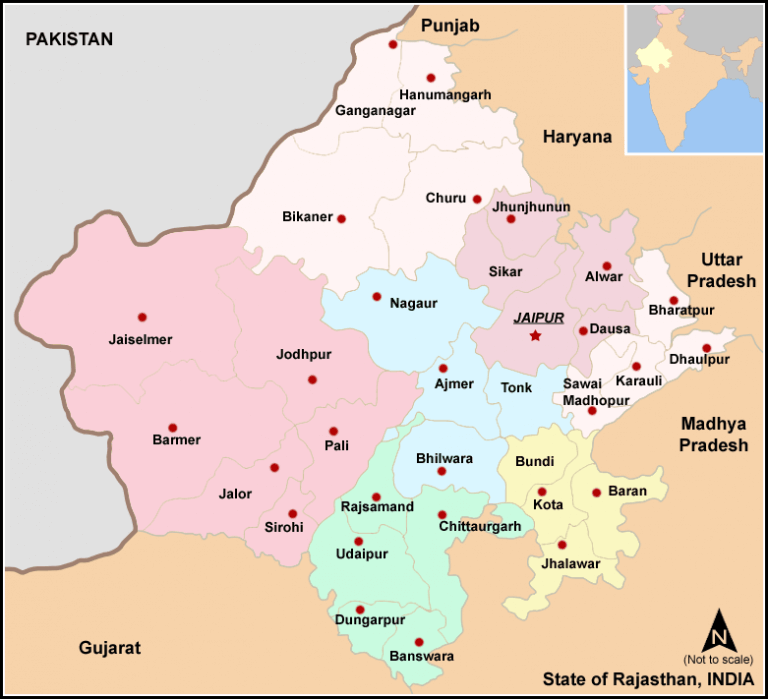
- Capital – Jaipur
- Language – Marwari language
- Population-6.89 CRORES
- Area – 342,239 km²
- Dance – Ghoomar
- Mammal – Indian Gazelle (Chinkara), nilgai (Blue bull)
- Tree – Jand
- Flower – Tecomella
Rajasthan in northwestern India is the largest state in India.
The land has scrub vegetation and has scarce rainfall. Millets, wheat, barley, rice, lentils, cotton, and tobacco are grown.
The history of Rajasthan, the palaces, golden-sand deserts, handicrafts and cuisine are the major attractions.
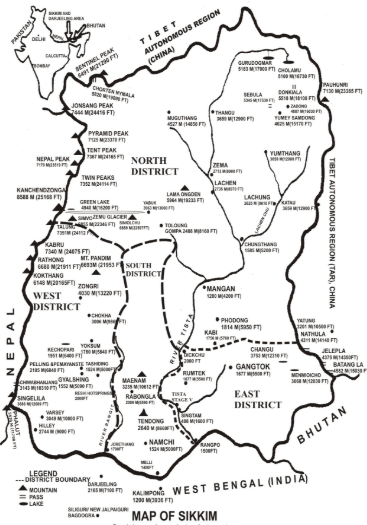
- Capital – Gangtok
- Language – Nepali
- Population- 6.19 lakhs
- Area – 7,096 km²
- Dance – Mask Dance
- Mammal – snow leopard, musk deer, Himalayan tahr
- Tree – Rhododendron
- Flower – Noble orchid
Sikkim, in the northeastern part of India, is the smallest state of India. Agriculture is the basis of the economy.
Vegetables and tea are grown. Sikkim is a major producer of cardamom.
India’s highest mountain peak, Kanchenjunga is in Sikkim. Sikkim is known for its scenic beauty of mountain peaks, glaciers, lakes and ancient monasteries.
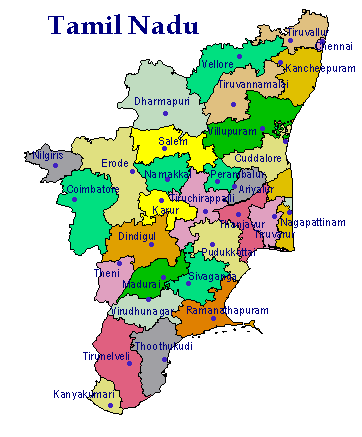
- Capital – Chennai
- Language – Tamil
- Population-6.79 crores
- Area – 130,060 km²
- Dance – Karagattam
- Mammal – Nilgiri tahr
- Tree – Palmyrah
- Flower – Flame lily
Tamil Nadu is the southern states of India
The town of Kanyakumari, at India’s southernmost tip, is famed for the sunrise at the confluence of three seas.
With lots of culture and religious heritage to its credit Tamil Nadu provides a mixture of the old and the new.
Agriculture and fishing is their occupation. It does have a manufacturing sector for automobiles, agricultural equipment, railway coaches etc.
Also Read: 9 Union Territories and their Capitals of India
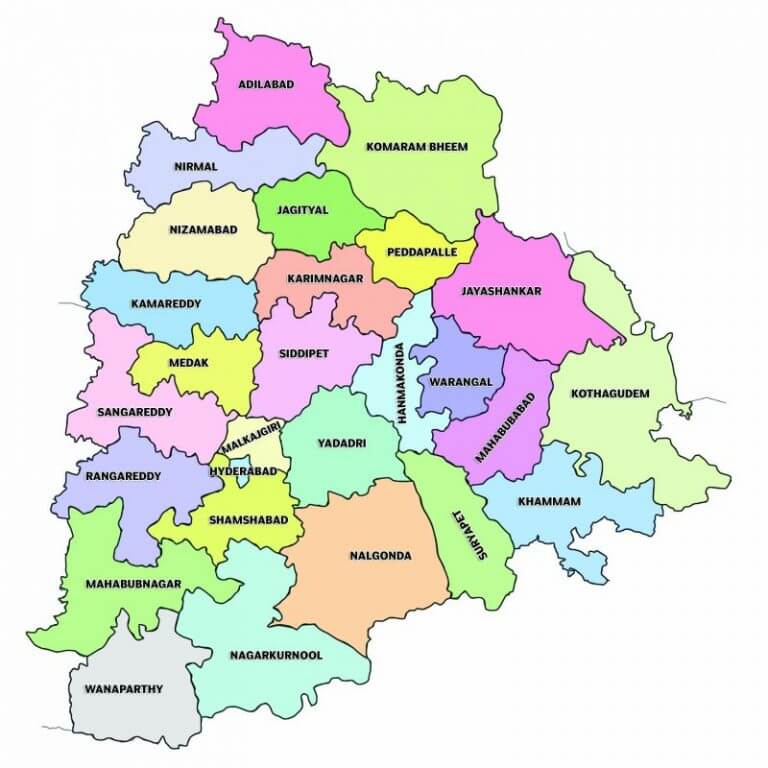
- Capital – Hyderabad
- Language – Telugu
- Population- 3.52 crores
- Area – 112,077 km²
- Dance – Perini Shivathandavam
- Mammal – Spotted deer
- Tree – Jammi Chettu
- Flower – Senna auriculata
Telangana is the newest state in south India comprising of ten districts of Andhra Pradesh.
The Charminar, Golconda Fort and Laad Bazar portray the history of the place.
The rivers Krishna and Godavari provide irrigation to the predominantly agriculture-based economy.
The industrial sector manufacturing electrical equipment and machine tools, pharmaceuticals have recently boosted the economy.
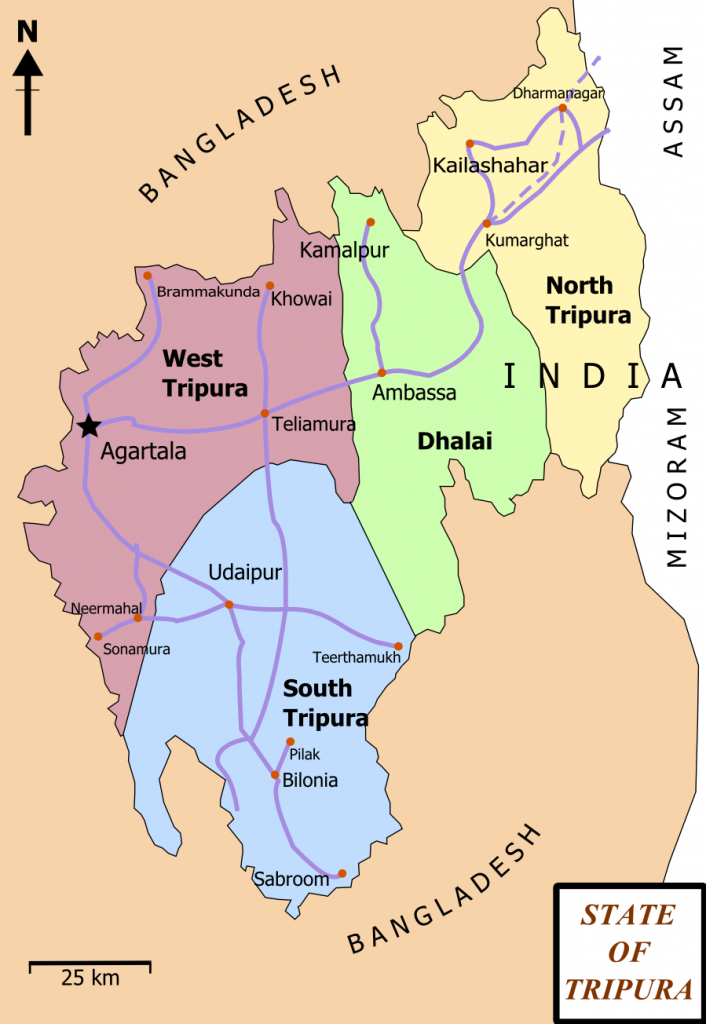
- Capital – Agartala
- Language – Bengali
- Population- 36.6 lakhs
- Area – 10,492 km²
- Dance – Vasant
- Mammal – elephant, sloth bear, Indian wolf
- Tree – Agar (Aquilaria malaccensis)
- Flower – Mesua ferrea
Tripura situated in north-east India is a land-locked state at the foothills of the Himalayas.
It is bordered by Bangladesh on three sides. Half the land area is covered by forests and is inhabited by animals and visited by migratory birds.
Rice is the major crop grown throughout the state. History, tradition, mountains, and forests beckon visitors to the state.
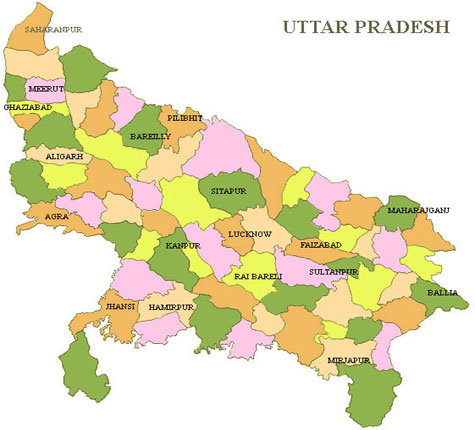
- Capital – Lucknow
- Language – Hindi
- Population- 20.42 crores
- Area – 243,286 km²
- Dance – Charkula Dance
- Mammal – Barasingha
- Tree – Ashok
- Flower – Brahm Kamal
Uttar Pradesh in North India is the most populous state in the country. Apart from the forests in the southern region, the terrain has mostly scrub vegetation.
Agriculture is the mainstay with rice, wheat, and sugarcane being the major crops.
The Taj Mahal, one of the wonders of the world, is at Agra. The cities of Varanasi and Prayaga, sacred to Hindus are in Uttar Pradesh.
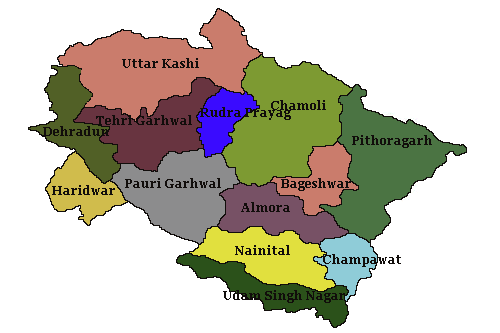
- Capital – Dehradun
- Language – Hindi; Sanskrit
- Population- 1.01 crores
- Area – 53,483 km²
- Dance – Chhollyia Folk Dance
- Mammal – Tiger, Deer, Sloth bear
- Tree – Burans
- Flower – Saussurea obvallata
Uttarakhand is a state in Northern India nestled in the lap of Himalayas.
The state has international borders with Tibet and Nepal. The population depends on agriculture for their livelihood.
The popular tourist destinations, hill stations at Mussoorie, Nainital, Dehradun and pilgrimage centers at Rishikesh, Haridwar, Kedarnath, Badrinath are all located in this picturesque state.
The world-famous Kumbh Mela is held at Haridwar every 12 years.
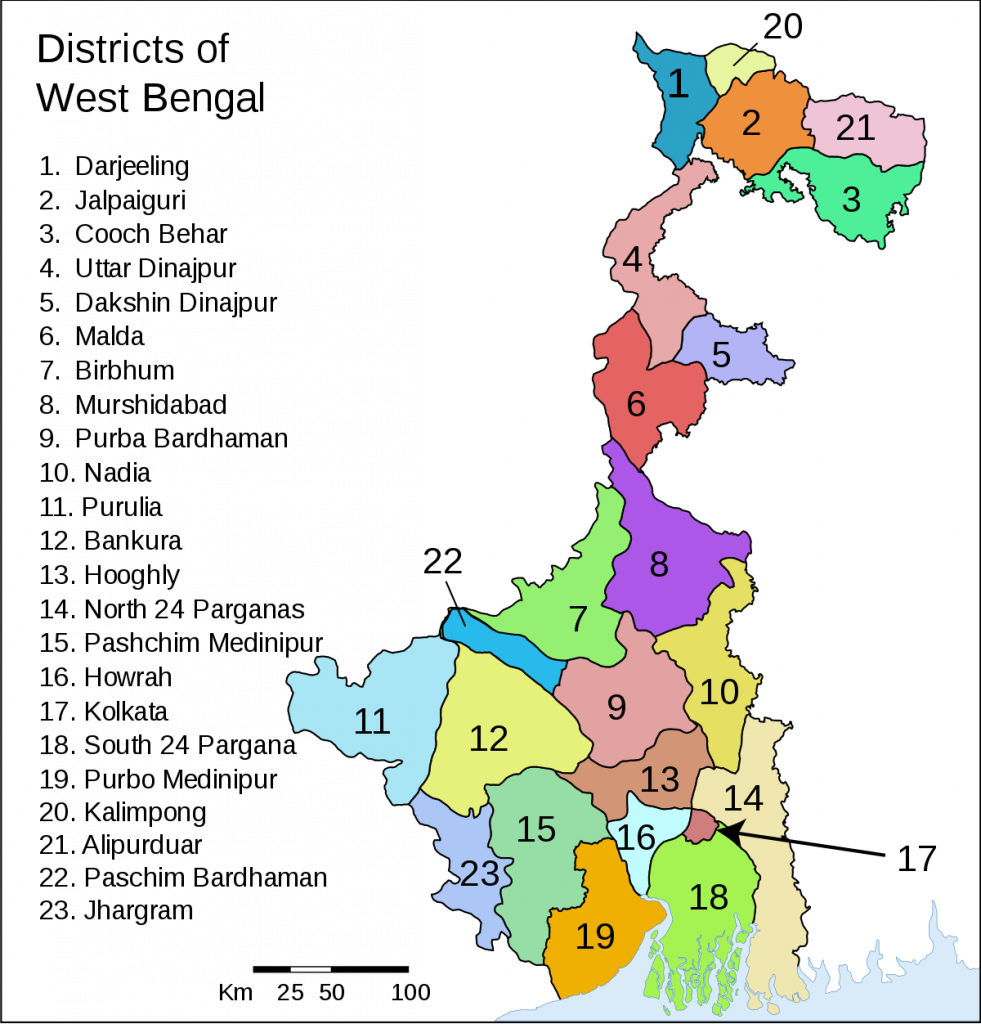
- Capital – Kolkata
- Language – Bengali.
- Population- 9.03 crores
- Area – 88,752
- Dance – Chhau Dance
- Mammal – Fishing cat
- Tree – Chatian
- Flower – Shephali
West Bengal lies to the east of India between the Himalayas and the Bay of Bengal.
The topography includes forests and mangroves of the Sundarbans. Agriculture based economy produces a significant quantity of rice along with jute, sugarcane, and oilseeds.
The tea produced in the hills of Darjeeling is of high quality.
The capital city’s landmark buildings and the Victoria Memorial remain as remnants of the past as the headquarters of the East India Company and capital of British Raj.
Indian States: Union Territories and Capitals
The union territories are usually federal territories governed directly by the central government of India.
The key reasons behind their creation include small population & land size, administrative importance, protection of indigenous cultures, and strategic locations.
According to July 2020, here are the details of the 8 Union Territories and their capitals along with the year in which they were founded.
|
Union Territories Names |
Capital |
Founded on |
|
Andaman and Nicobar Islands |
Port Blair |
1 Nov. 1956 |
|
Chandigarh |
Chandigarh |
1 Nov. 1966 |
|
Dadra & Nagar Haveli and Daman & Diu |
Daman |
26 Jan. 2020 |
|
Delhi |
New Delhi |
9 May. 1905 |
|
Jammu and Kashmir |
Srinagar (Summer) |
31 Oct 2019 |
|
Lakshadweep |
Kavaratti |
1 Nov. 1956 |
|
Puducherry |
Pondicherry |
1 Nov. 1954 |
|
Ladakh |
Leh |
31 Oct 2019 |
States and Capitals of India Map
The following states and capitals of India map will give a clear idea about the geographical distribution of the Indian states as well as the state and international boundaries.

States and Union Territories: What You Should Know?
As we have discussed earlier, India is divided into different states and union territories for administrative convenience.
Each union territory and state has a capital of its own. However, there are some key differences in the way they function. Let us have a look.
|
State |
Union Territories |
|
Executive Head is the Governor
|
Executive Head is the President
|
|
The state comprises administrative units and each of them with separate elected government. |
Central Government administers and controls Union Territories which are constituent units |
|
People elects a Chief Minister for administration |
President appoints an administrator for administration (Jammu & Kashmir, Puducherry and Delhi are exceptions)
|
|
The relationship with the Centre is Federal. |
Unitary with the Centre. i.e. all the powers rests in the hands of Union. |
|
Chief Minister is the real head. |
Lieutenant is the real head. |
States and Capitals of India: UT Updates and Specialities
There are a few new updates on Union Territories as of July 2020. Also Delhi, Puducherry, J& K are not similar to other Union Territories. Let us take a glance into the important details:
- The number of Union Territories in India has come down to 8 followed by the merging of Daman and Diu, and Dadra and Nagar Haveli.
- As per the latest proceedings, the U.T Daman and Diu, Dadra and Nagar Haveli are now a single union territory. This new update is in effect since 26th January 2020.
- A special status was specified for Jammu and Kashmir under Article 370 but lately, the central government has declared its abrogation. Following, there was a partition into 2 Union Territories i.e. UTs of Ladakh and Jammu and Kashmir.
- An amendment to the Constitution has granted partial statehood for these states and has their elected Chief Minister and members.
- These 3 union territories operate like states and possess their own legislative assembly and executive council.
Interesting Facts about States and Capitals of India
Here are some interesting facts about the states and capitals of India that every kid should know.
- Capital of India is New Delhi and the states and territories of the country are further subdivided into districts
- The territorial high courts are located in a judicial capital.
- A legislative capital of the state is where the state assembly convenes
- All the offices of the executive government are situated in an administrative capital.
- In the states, the Governor, as the representative of the President, is the head of Executive.
- The first Indian state which was created based on a linguistic basis before independence is Odisha and the one after independence is Andhra Pradesh.
- In 1960, Maharashtra and Gujarat were formed as two separate states from the Indian state of Bombay.
- Chennai, capital of Tamilnadu was once a no man’s land in 1639 but now a major business, industrial and cultural center
- Capital of Kerala, Trivandrum is a clean town formed over 7 hills, which is also famous as Thiru-Anantha-Puram, which represents the ideology, ‘the town of Lord Anantha’
- Jaipur, the capital of Rajasthan was the first planned city of India. Due to its pink colored buildings, it is popularly known as the ‘Pink City of Rajasthan’.
- In 1948, Bhubaneswar replaced Cuttack as the capital of Odisha. It is also known as the ‘temple city of India’.
- Bhopal, the capital of Madhya Pradesh is known for its various natural as well as artificial lakes. So it is also known as the ‘city of lakes’.
- Bengaluru, the capital of Karnataka is the nation’s leading information technology (IT), exporter. So it is also known as the ‘Silicon Valley of India’.
- Uttar Pradesh is the Indian state which shares the maximum number of borders with other states
- The largest Indian state by area is Rajasthan and the smallest is Goa
- The state which was earlier the summer capital of British India is Shimla, Himachal Pradesh.
- The Indian state that has the maximum number of districts is Uttar Pradesh with 75 districts.
- The Indian state that has the lowest number of districts is Goa with 2 districts.
- Uttarakhand and Jammu and Kashmir have two separate capitals for summer and winter seasons.
- Chandigarh is the capital of two states Punjab and Haryana. It is also regarded as a union territory.
- The Indian states Nagaland, Himachal Pradesh, Manipur, Tripura, Arunachal Pradesh and Goa were earlier union territories.
- Before its formation as an individual state, Kerala was State of Travancore and Cochin, Andhra was part of Madras, Haryana was part of Punjab, Uttarakhand was part of Uttar Pradesh, Chhattisgarh was part of Madhya Pradesh, Jharkhand was part of Bihar, Telangana was part of Andhra Pradesh and Meghalaya was an autonomous state within state of Assam.
Access Here More Than 1000+ FREE Educational Apps
Hope this blog gives a great idea about the states and capitals of India. Parents and teachers can brief kids about these interesting facts about the peculiarity of the nation and invoke their interest to explore more about the subject when they go up higher classes.
Recent Blogs
Our Educational Services
Popular Blogs
Subscribe

SUBSCRIBE TO OUR NEWSLETTER
Sign Up and Recieve the Latest News
Don’t Worry, We Don’t SpamExplore Our Extensive Researched Educational App Directory
Visit Now

















